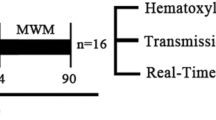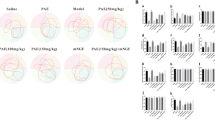Abstract
Tripterygium Wilfordii Hook F has been exploited as a treatment for several diseases due to its neuroprotective, anti-tumor, and anti-inflammatory effects. Triptolide is one of its key bioactive compounds. Currently, the role of triptolide in cognitive dysfunction remains unclear. Here, the role of triptolide on cognitive dysfunction was investigated using chronic cerebral hypoperfusion-induced vascular dementia (VD) rat model. SD rats were administrated with Triptolide (5 μg/kg) for 6 weeks after undergoing permanent bilateral common carotid artery occlusion. The results show that triptolide treatment conferred neuroprotective effects in VD rats. Intraperitoneal injection of triptolide attenuated oxidative stress, learning and memory deficits, and neuronal apoptosis in the hippocampi. Moreover, triptolide enhanced the expression of SIRT1, PGC-1α, ZO-1, Claudin-5, and decreased the serum levels of NSE and S100B significantly. It also improved CCH-induced learning and memory deficits, and this is attributed to its capacity to promote SIRT1/PGC-1α signaling, confer antioxidant effects, and inhibit neuronal apoptosis. These findings indicate that triptolide may be an effective therapeutic agent for vascular cognitive dysfunction.




Similar content being viewed by others
References
Khan A, Kalaria RN, Corbett A et al (2016) Update on vascular dementia. J Geriatr Psychiatry Neurol 29(5):281–301
Kalaria RN, Akinyemi R, Ihara M (2016) Stroke injury, cognitive impairment and vascular dementia. Biochim Biophys Acta 5:915–925
Wiesmann M, Kiliaan AJ, Claassen JA (2013) Vascular aspects of cognitive impairment and dementia. J Cereb Blood Flow Metab 33(11):1696–1706
Yang T, Sun Y, Lu Z et al (2017) The impact of cerebrovascular aging on vascular cognitive impairment and dementia. Ageing Res Rev 34:15–29
Du SQ, Wang XR, Xiao LY et al (2017) Molecular mechanisms of vascular dementia: what can be learned from animal models of chronic cerebral hypoperfusion? Mol Neurobiol 54(5):3670–3682
Tsuchiya M, Sako K, Yura S et al (1993) Local cerebral glucose utilisation following acute and chronic bilateral carotid artery ligation in Wistar rats: relation to changes in local cerebral blood flow. Exp Brain Res 95(1):1–7
Bennett S, Grant MM, Aldred S (2009) Oxidative stress in vascular dementia and Alzheimer’s disease: a common pathology. J Alzheimers Dis 17(2):245–257
Gustaw-Rothenberg K, Kowalczuk K, Stryjecka-Zimmer M (2010) Lipids’ peroxidation markers in Alzheimer’s disease and vascular dementia. Geriatr Gerontol Int 10(2):161–166
Zhang X, Wu B, Nie K et al (2014) Effects of acupuncture on declined cerebral blood flow, impaired mitochondrial respiratory function and oxidative stress in multi-infarct dementia rats. Neurochem Int 65:23–29
Zhang XY, Zhang XJ, Xv J et al (2018) Crocin attenuates acute hypobaric hypoxia-induced cognitive deficits of rats. Eur J Pharmacol 818:300–305
Fu B, Zhang J, Zhang X et al (2014) Alpha-lipoic acid upregulates SIRT1-dependent PGC-1alpha expression and protects mouse brain against focal ischemia. Neuroscience 281:251–257
Corbi G, Conti V, Russomanno G et al (2013) Adrenergic signaling and oxidative stress: a role for sirtuins? Front Physiol 4:324
Helisalmi S, Vepsalainen S, Hiltunen M et al (2008) Genetic study between SIRT1, PPARD, PGC-1alpha genes and Alzheimer’s disease. J Neurol 255(5):668–673
Koo JH, Cho JY (2017) Treadmill exercise attenuates alpha-synuclein levels by promoting mitochondrial function and autophagy possibly via SIRT1 in the chronic MPTP/P-induced mouse model of Parkinson’s disease. Neurotox Res 32(3):473–486
Donmez G, Wang D, Cohen DE et al (2010) SIRT1 suppresses beta-amyloid production by activating the alpha-secretase gene ADAM10. Cell 142(2):320–332
Zhou Y, Wang S, Li Y et al (2017) SIRT1/PGC-1alpha signaling promotes mitochondrial functional recovery and reduces apoptosis after intracerebral hemorrhage in rats. Front Mol Neurosci 10:443
Li XJ, Jiang ZZ, Zhang LY (2014) Triptolide: progress on research in pharmacodynamics and toxicology. J Ethnopharmacol 155(1):67–79
Liu Q (2017) Triptolide and its expanding multiple pharmacological functions. Int Immunopharmacol 11(3):377–383
Hao M, Li X, Feng J et al (2015) Triptolide protects against ischemic stroke in rats. Inflammation 38(4):1617–1623
Li R, Lu K, Wang Y et al (2017) Triptolide attenuates pressure overload-induced myocardial remodeling in mice via the inhibition of NLRP3 inflammasome expression. Biochem Biophys Res Commun 485(1):69–75
Zhang YQ, Shen Y, Liao MM et al (2019) Galactosylated chitosan triptolide nanoparticles for overcoming hepatocellular carcinoma: enhanced therapeutic efficacy, low toxicity, and validated network regulatory mechanisms. Nanomedicine 15(1):86–97
Lu Y, Bao X, Sun T et al (2012) Triptolide attenuate the oxidative stress induced by LPS/D-GalN in mice. J Cell Biochem 113(3):1022–1033
Nie J, Zhou M, Lu C et al (2012) Effects of triptolide on the synaptophysin expression of hippocampal neurons in the AD cellular model. Int Immunopharmacol 13(2):175–180
Cheng S, Leblanc KJ, Li L (2014) Triptolide preserves cognitive function and reduces neuropathology in a mouse model of Alzheimer’s disease. PLoS ONE 9(9):e108845
Hajdukova L, Sobek O, Prchalova D et al (2015) Biomarkers of brain damage: S100B and NSE concentrations in cerebrospinal fluid—a normative study. Biomed Res Int 2015:379071
Chen Y, Guo Z, Peng X et al (2018) Nimodipine represses AMPK phosphorylation and excessive autophagy after chronic cerebral hypoperfusion in rats. Brain Res Bull 140:88–96
Farkas E, Luiten PG, Bari F (2007) Permanent, bilateral common carotid artery occlusion in the rat: a model for chronic cerebral hypoperfusion-related neurodegenerative diseases. Brain Res Rev 54(1):162–180
Ma X, Xu W, Zhang Z et al (2017) Salvianolic acid B ameliorates cognitive deficits through IGF-1/Akt pathway in rats with vascular dementia. Cell Physiol Biochem 43(4):1381–1391
Dias IH, Polidori MC, Griffiths HR (2014) Hypercholesterolaemia-induced oxidative stress at the blood-brain barrier. Biochem Soc Trans 42(4):1001–1005
Stamatovic SM, Martinez-Revollar G, Hu A et al (2019) Decline in sirtuin-1 expression and activity plays a critical role in bloodbrain barrier permeability in aging. Neurobiol Dis 126:105-116.
Zheng CX, Chen ZH, Zeng CH et al (2008) Triptolide protects podocytes from puromycin aminonucleoside induced injury in vivo and in vitro. Kidney Int 74(5):596–612
Fan D, He X, Bian Y et al (2016) Triptolide modulates TREM-1 signal pathway to inhibit the inflammatory response in rheumatoid arthritis. Int J Mol Sci 17(4):498
Aguirre-Rueda D, Guerra-Ojeda S, Aldasoro M et al (2015) Astrocytes protect neurons from Abeta1-42 peptide-induced neurotoxicity increasing TFAM and PGC-1 and decreasing PPAR-gamma and SIRT-1. Int J Med Sci 12(1):48–56
He XL, Wang YH, Bi MG et al (2012) Chrysin improves cognitive deficits and brain damage induced by chronic cerebral hypoperfusion in rats. Eur J Pharmacol 680(1–3):41–48
Kwon KJ, Lee EJ, Kim MK et al (2015) Diabetes augments cognitive dysfunction in chronic cerebral hypoperfusion by increasing neuronal cell death: implication of cilostazol for diabetes mellitus-induced dementia. Neurobiol Dis 73:12–23
Kim MS, Bang JH, Lee J et al (2015) Salvia miltiorrhiza extract protects white matter and the hippocampus from damage induced by chronic cerebral hypoperfusion in rats. BMC Complement Altern Med 15:415
Acknowledgements
This work was supported by the National Natural Science Foundation of China (No. 81560193), Science and Technology Research Project of Education Department of Jiangxi Province (No. GJJ180019), Science and Technology Research Project of Health and Health committee Department of Jiangxi Province (20195231).
Author information
Authors and Affiliations
Corresponding author
Ethics declarations
Conflict of interest
The authors declare that there is no conflict of interests regarding the publication of this article.
Additional information
Publisher's Note
Springer Nature remains neutral with regard to jurisdictional claims in published maps and institutional affiliations.
Rights and permissions
About this article
Cite this article
Yao, P., Li, Y., Yang, Y. et al. Triptolide Improves Cognitive Dysfunction in Rats with Vascular Dementia by Activating the SIRT1/PGC-1α Signaling Pathway. Neurochem Res 44, 1977–1985 (2019). https://doi.org/10.1007/s11064-019-02831-3
Received:
Revised:
Accepted:
Published:
Issue Date:
DOI: https://doi.org/10.1007/s11064-019-02831-3




